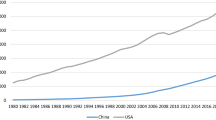Abstract
It is widely known that Chinese transition to market economy was influenced by the newly industrialized Asian countries—Malaysia, Taiwan, and Hong Kong—but it is not as much evident that Chinese reform was also influenced by the economic reforms of Hungary. Hungary started market-oriented reforms in the late 1960s by introducing market-orientated measures in agriculture, in manufacturing, in retail trade, and in finances, which made Hungarian economy more flexible and efficient than other European socialist countries. It could be shown that the first market-oriented reform measures applied in China during the 1980s and 1990s have large similarities to the Hungarian reform introduced earlier. In that respect, we can say that Chinese economic reform has adapted lots of elements of the early Hungarian economic reform. At the same time, Hungarian reforms have died away, but after the “lost decade of the 1980s,” there was an extremely rapid transition to market economy, which—in spite of the seemingly successful beginning—could not contribute to a long-term and healthy economic development. Meanwhile in China, economic reform was rather successful, resulting in an unprecedented economic development at the end of the twentieth century. Authors of the present article analyse similarities of the Hungarian and Chinese reforms and try to explain the causes of the Hungarian failure and the Chinese success. “Let China Sleep, for when the Dragon awakes, she will shake the world.” The saying is attributed to Napoleon and he seems to have been right. Now that China has reversed the process of globalization and has become the winner, we should resignedly accept that China is wide awake. The country's economy has followed a rapid growth path thus China's economic dominance is felt in the entire Far East; moreover, the country with the highest population in the world the country is taking steps to emerge as a world power. The dragon is awake, and she is not going to take a great leap forward but instead it is now on the long march. In lieu of her specific tools, China is about to win: she is already one of the winners, if not the only winner of globalization.
Similar content being viewed by others
References
Arva L (1990) Overtaking—the reasons for success and failure in rapidly industrialising countries. Közgazdasági és Jogi Könyvkiadó, Budapest, Előzésben, a gyorsan iparosodó dél-kelet-ázsiai országok sikereinek és ritka kudarcainak okai
Arva L, Sebők E (1984) Joint ventures in export processing zones: a new possibility. Külgazdaság 3:28–39, Vámszabad területi vegyes vállalat: egy új lehetőség
Arva L, Schlett A (2011) A copy better than the original. június 11:6, Kína: Jobb a másolat, mint az eredeti, In: Magyar Nemzet, 2011
Castells M (1998) End of millennium, the information age: economy, society and culture, vol. III. Blackwell, Cambridge
Central Statistical Office database (2012) http://www.ksh.hu/docs/hun/xstadat/xstadat_hosszu/h_qli001.html
Fehér I (2008) Applying historical precedent to new conventional wisdom on public sector roles in agriculture and rural development. Ups and downs of the Hungarian agricultural model; FAO, country case study
Katona K (2007) Choices and options on the capital market. The role of foreign working capital int he Hungarian transition. Gondolat Kiadó, Budapest, Vonzások és választások a tőkepiacon. A külföldi működőtőke-befektetések elmélete és szerepe a magyar gazdasági átalakulásban
Katona K (2010) A külföldi tőkebefektetések okainak változása Kelet-Közép-Európában. (Changes in the reasons for foreign investment in Central Eastern Europe). Pénzügyi Szemle, 3. sz. 656–673
Lisányi EBJ (2010) Magyarország és Dánia mezőgazdasági fejlődésének tanulságai (The lessons of the agricultural development process in Denmark and Hungary). In: A falu. Agroinformkiadó, 2010 Spring, XXV. évf. 1. szám, pp. 49–60
Needham J (1995) Science et Civilisation en Chine. Une Introduction. Editeur: Philippe Picquier
Pogátsa Z (2009) Hungary: from star transition student to backsliding member state. J Contemp Eur Res 5(4):1–17
Schlett A (2007) The island on dry land. Szent István Társulat, Budapest, pp 95–99, Sziget a szárazföldön
Sik O (1991a) Socialism today? In: Sik O (ed) The changing meaning of socialism. Macmillan, London
Sik Ota (1991) Jövőnk gazdasága, Közgazdasági És Jogi Kiadó, 1991
Vámos P (2012) The Hungarian model and China. Historia 4:19–24, A Magyar model és Kína
Weisbrot M, Ray R (2011) The scorecard on development, 1960–2010: closing the gap? CEPR. 2011. April
WSPiZ (2004) Lessons of China's Transition from a planned economy to a market economy. Leon Koźmiski Academy of Entrepreneurship and Management (WSPiZ) and TIGER Distinguished Lectures Series n. 16 Warsaw, 17 December 2004
Acknowledgments
This study was supported by the Hungarian New Széchenyi Plan TÁMOP-4.2.1.B-11/2/KMR-2011-0002.
Author information
Authors and Affiliations
Corresponding author
Rights and permissions
About this article
Cite this article
Árva, L., Schlett, A. The long march: the lessons of China's economic transition. Asia Eur J 11, 39–52 (2013). https://doi.org/10.1007/s10308-013-0340-z
Received:
Revised:
Accepted:
Published:
Issue Date:
DOI: https://doi.org/10.1007/s10308-013-0340-z




